Input interpretation
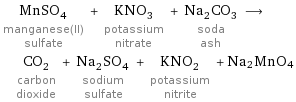
MnSO_4 manganese(II) sulfate + KNO_3 potassium nitrate + Na_2CO_3 soda ash ⟶ CO_2 carbon dioxide + Na_2SO_4 sodium sulfate + KNO_2 potassium nitrite + Na2MnO4
Balanced equation
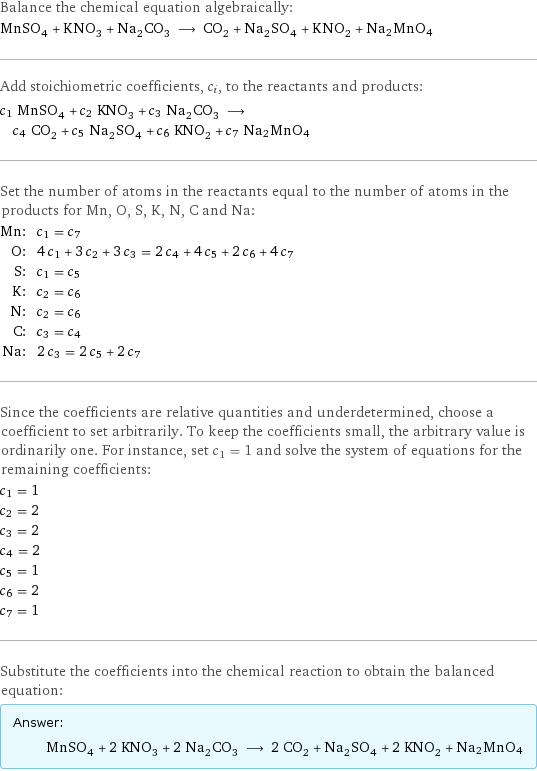
Balance the chemical equation algebraically: MnSO_4 + KNO_3 + Na_2CO_3 ⟶ CO_2 + Na_2SO_4 + KNO_2 + Na2MnO4 Add stoichiometric coefficients, c_i, to the reactants and products: c_1 MnSO_4 + c_2 KNO_3 + c_3 Na_2CO_3 ⟶ c_4 CO_2 + c_5 Na_2SO_4 + c_6 KNO_2 + c_7 Na2MnO4 Set the number of atoms in the reactants equal to the number of atoms in the products for Mn, O, S, K, N, C and Na: Mn: | c_1 = c_7 O: | 4 c_1 + 3 c_2 + 3 c_3 = 2 c_4 + 4 c_5 + 2 c_6 + 4 c_7 S: | c_1 = c_5 K: | c_2 = c_6 N: | c_2 = c_6 C: | c_3 = c_4 Na: | 2 c_3 = 2 c_5 + 2 c_7 Since the coefficients are relative quantities and underdetermined, choose a coefficient to set arbitrarily. To keep the coefficients small, the arbitrary value is ordinarily one. For instance, set c_1 = 1 and solve the system of equations for the remaining coefficients: c_1 = 1 c_2 = 2 c_3 = 2 c_4 = 2 c_5 = 1 c_6 = 2 c_7 = 1 Substitute the coefficients into the chemical reaction to obtain the balanced equation: Answer: | | MnSO_4 + 2 KNO_3 + 2 Na_2CO_3 ⟶ 2 CO_2 + Na_2SO_4 + 2 KNO_2 + Na2MnO4
Structures
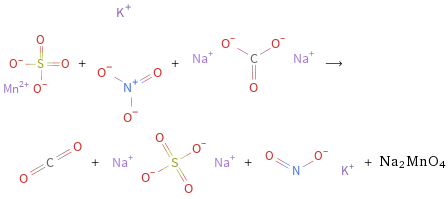
+ + ⟶ + + + Na2MnO4
Names

manganese(II) sulfate + potassium nitrate + soda ash ⟶ carbon dioxide + sodium sulfate + potassium nitrite + Na2MnO4
Equilibrium constant
![Construct the equilibrium constant, K, expression for: MnSO_4 + KNO_3 + Na_2CO_3 ⟶ CO_2 + Na_2SO_4 + KNO_2 + Na2MnO4 Plan: • Balance the chemical equation. • Determine the stoichiometric numbers. • Assemble the activity expression for each chemical species. • Use the activity expressions to build the equilibrium constant expression. Write the balanced chemical equation: MnSO_4 + 2 KNO_3 + 2 Na_2CO_3 ⟶ 2 CO_2 + Na_2SO_4 + 2 KNO_2 + Na2MnO4 Assign stoichiometric numbers, ν_i, using the stoichiometric coefficients, c_i, from the balanced chemical equation in the following manner: ν_i = -c_i for reactants and ν_i = c_i for products: chemical species | c_i | ν_i MnSO_4 | 1 | -1 KNO_3 | 2 | -2 Na_2CO_3 | 2 | -2 CO_2 | 2 | 2 Na_2SO_4 | 1 | 1 KNO_2 | 2 | 2 Na2MnO4 | 1 | 1 Assemble the activity expressions accounting for the state of matter and ν_i: chemical species | c_i | ν_i | activity expression MnSO_4 | 1 | -1 | ([MnSO4])^(-1) KNO_3 | 2 | -2 | ([KNO3])^(-2) Na_2CO_3 | 2 | -2 | ([Na2CO3])^(-2) CO_2 | 2 | 2 | ([CO2])^2 Na_2SO_4 | 1 | 1 | [Na2SO4] KNO_2 | 2 | 2 | ([KNO2])^2 Na2MnO4 | 1 | 1 | [Na2MnO4] The equilibrium constant symbol in the concentration basis is: K_c Mulitply the activity expressions to arrive at the K_c expression: Answer: | | K_c = ([MnSO4])^(-1) ([KNO3])^(-2) ([Na2CO3])^(-2) ([CO2])^2 [Na2SO4] ([KNO2])^2 [Na2MnO4] = (([CO2])^2 [Na2SO4] ([KNO2])^2 [Na2MnO4])/([MnSO4] ([KNO3])^2 ([Na2CO3])^2)](../image_source/3f0107ed9bc7ae4c363aff65ebd318da.png)
Construct the equilibrium constant, K, expression for: MnSO_4 + KNO_3 + Na_2CO_3 ⟶ CO_2 + Na_2SO_4 + KNO_2 + Na2MnO4 Plan: • Balance the chemical equation. • Determine the stoichiometric numbers. • Assemble the activity expression for each chemical species. • Use the activity expressions to build the equilibrium constant expression. Write the balanced chemical equation: MnSO_4 + 2 KNO_3 + 2 Na_2CO_3 ⟶ 2 CO_2 + Na_2SO_4 + 2 KNO_2 + Na2MnO4 Assign stoichiometric numbers, ν_i, using the stoichiometric coefficients, c_i, from the balanced chemical equation in the following manner: ν_i = -c_i for reactants and ν_i = c_i for products: chemical species | c_i | ν_i MnSO_4 | 1 | -1 KNO_3 | 2 | -2 Na_2CO_3 | 2 | -2 CO_2 | 2 | 2 Na_2SO_4 | 1 | 1 KNO_2 | 2 | 2 Na2MnO4 | 1 | 1 Assemble the activity expressions accounting for the state of matter and ν_i: chemical species | c_i | ν_i | activity expression MnSO_4 | 1 | -1 | ([MnSO4])^(-1) KNO_3 | 2 | -2 | ([KNO3])^(-2) Na_2CO_3 | 2 | -2 | ([Na2CO3])^(-2) CO_2 | 2 | 2 | ([CO2])^2 Na_2SO_4 | 1 | 1 | [Na2SO4] KNO_2 | 2 | 2 | ([KNO2])^2 Na2MnO4 | 1 | 1 | [Na2MnO4] The equilibrium constant symbol in the concentration basis is: K_c Mulitply the activity expressions to arrive at the K_c expression: Answer: | | K_c = ([MnSO4])^(-1) ([KNO3])^(-2) ([Na2CO3])^(-2) ([CO2])^2 [Na2SO4] ([KNO2])^2 [Na2MnO4] = (([CO2])^2 [Na2SO4] ([KNO2])^2 [Na2MnO4])/([MnSO4] ([KNO3])^2 ([Na2CO3])^2)
Rate of reaction
![Construct the rate of reaction expression for: MnSO_4 + KNO_3 + Na_2CO_3 ⟶ CO_2 + Na_2SO_4 + KNO_2 + Na2MnO4 Plan: • Balance the chemical equation. • Determine the stoichiometric numbers. • Assemble the rate term for each chemical species. • Write the rate of reaction expression. Write the balanced chemical equation: MnSO_4 + 2 KNO_3 + 2 Na_2CO_3 ⟶ 2 CO_2 + Na_2SO_4 + 2 KNO_2 + Na2MnO4 Assign stoichiometric numbers, ν_i, using the stoichiometric coefficients, c_i, from the balanced chemical equation in the following manner: ν_i = -c_i for reactants and ν_i = c_i for products: chemical species | c_i | ν_i MnSO_4 | 1 | -1 KNO_3 | 2 | -2 Na_2CO_3 | 2 | -2 CO_2 | 2 | 2 Na_2SO_4 | 1 | 1 KNO_2 | 2 | 2 Na2MnO4 | 1 | 1 The rate term for each chemical species, B_i, is 1/ν_i(Δ[B_i])/(Δt) where [B_i] is the amount concentration and t is time: chemical species | c_i | ν_i | rate term MnSO_4 | 1 | -1 | -(Δ[MnSO4])/(Δt) KNO_3 | 2 | -2 | -1/2 (Δ[KNO3])/(Δt) Na_2CO_3 | 2 | -2 | -1/2 (Δ[Na2CO3])/(Δt) CO_2 | 2 | 2 | 1/2 (Δ[CO2])/(Δt) Na_2SO_4 | 1 | 1 | (Δ[Na2SO4])/(Δt) KNO_2 | 2 | 2 | 1/2 (Δ[KNO2])/(Δt) Na2MnO4 | 1 | 1 | (Δ[Na2MnO4])/(Δt) (for infinitesimal rate of change, replace Δ with d) Set the rate terms equal to each other to arrive at the rate expression: Answer: | | rate = -(Δ[MnSO4])/(Δt) = -1/2 (Δ[KNO3])/(Δt) = -1/2 (Δ[Na2CO3])/(Δt) = 1/2 (Δ[CO2])/(Δt) = (Δ[Na2SO4])/(Δt) = 1/2 (Δ[KNO2])/(Δt) = (Δ[Na2MnO4])/(Δt) (assuming constant volume and no accumulation of intermediates or side products)](../image_source/508784df0bba08b4ebcafe416c1a8729.png)
Construct the rate of reaction expression for: MnSO_4 + KNO_3 + Na_2CO_3 ⟶ CO_2 + Na_2SO_4 + KNO_2 + Na2MnO4 Plan: • Balance the chemical equation. • Determine the stoichiometric numbers. • Assemble the rate term for each chemical species. • Write the rate of reaction expression. Write the balanced chemical equation: MnSO_4 + 2 KNO_3 + 2 Na_2CO_3 ⟶ 2 CO_2 + Na_2SO_4 + 2 KNO_2 + Na2MnO4 Assign stoichiometric numbers, ν_i, using the stoichiometric coefficients, c_i, from the balanced chemical equation in the following manner: ν_i = -c_i for reactants and ν_i = c_i for products: chemical species | c_i | ν_i MnSO_4 | 1 | -1 KNO_3 | 2 | -2 Na_2CO_3 | 2 | -2 CO_2 | 2 | 2 Na_2SO_4 | 1 | 1 KNO_2 | 2 | 2 Na2MnO4 | 1 | 1 The rate term for each chemical species, B_i, is 1/ν_i(Δ[B_i])/(Δt) where [B_i] is the amount concentration and t is time: chemical species | c_i | ν_i | rate term MnSO_4 | 1 | -1 | -(Δ[MnSO4])/(Δt) KNO_3 | 2 | -2 | -1/2 (Δ[KNO3])/(Δt) Na_2CO_3 | 2 | -2 | -1/2 (Δ[Na2CO3])/(Δt) CO_2 | 2 | 2 | 1/2 (Δ[CO2])/(Δt) Na_2SO_4 | 1 | 1 | (Δ[Na2SO4])/(Δt) KNO_2 | 2 | 2 | 1/2 (Δ[KNO2])/(Δt) Na2MnO4 | 1 | 1 | (Δ[Na2MnO4])/(Δt) (for infinitesimal rate of change, replace Δ with d) Set the rate terms equal to each other to arrive at the rate expression: Answer: | | rate = -(Δ[MnSO4])/(Δt) = -1/2 (Δ[KNO3])/(Δt) = -1/2 (Δ[Na2CO3])/(Δt) = 1/2 (Δ[CO2])/(Δt) = (Δ[Na2SO4])/(Δt) = 1/2 (Δ[KNO2])/(Δt) = (Δ[Na2MnO4])/(Δt) (assuming constant volume and no accumulation of intermediates or side products)
Chemical names and formulas
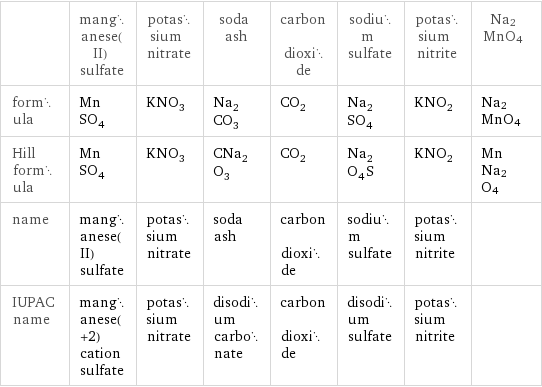
| manganese(II) sulfate | potassium nitrate | soda ash | carbon dioxide | sodium sulfate | potassium nitrite | Na2MnO4 formula | MnSO_4 | KNO_3 | Na_2CO_3 | CO_2 | Na_2SO_4 | KNO_2 | Na2MnO4 Hill formula | MnSO_4 | KNO_3 | CNa_2O_3 | CO_2 | Na_2O_4S | KNO_2 | MnNa2O4 name | manganese(II) sulfate | potassium nitrate | soda ash | carbon dioxide | sodium sulfate | potassium nitrite | IUPAC name | manganese(+2) cation sulfate | potassium nitrate | disodium carbonate | carbon dioxide | disodium sulfate | potassium nitrite |
Substance properties
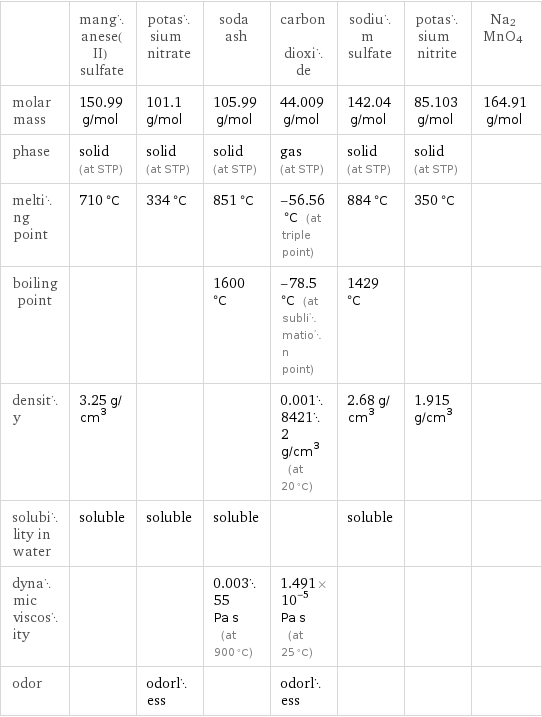
| manganese(II) sulfate | potassium nitrate | soda ash | carbon dioxide | sodium sulfate | potassium nitrite | Na2MnO4 molar mass | 150.99 g/mol | 101.1 g/mol | 105.99 g/mol | 44.009 g/mol | 142.04 g/mol | 85.103 g/mol | 164.91 g/mol phase | solid (at STP) | solid (at STP) | solid (at STP) | gas (at STP) | solid (at STP) | solid (at STP) | melting point | 710 °C | 334 °C | 851 °C | -56.56 °C (at triple point) | 884 °C | 350 °C | boiling point | | | 1600 °C | -78.5 °C (at sublimation point) | 1429 °C | | density | 3.25 g/cm^3 | | | 0.00184212 g/cm^3 (at 20 °C) | 2.68 g/cm^3 | 1.915 g/cm^3 | solubility in water | soluble | soluble | soluble | | soluble | | dynamic viscosity | | | 0.00355 Pa s (at 900 °C) | 1.491×10^-5 Pa s (at 25 °C) | | | odor | | odorless | | odorless | | |
Units
